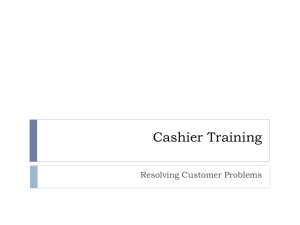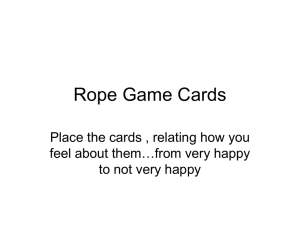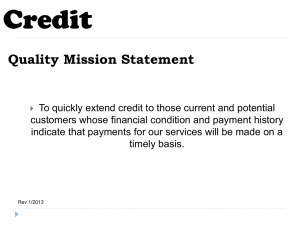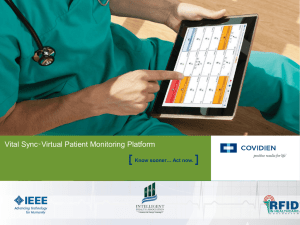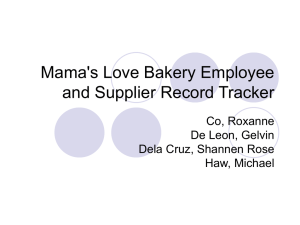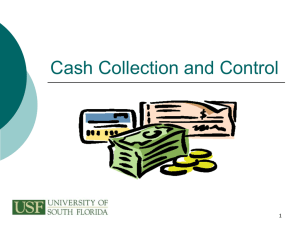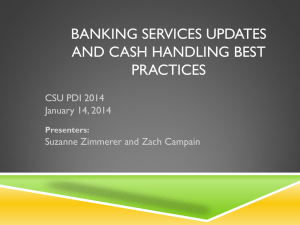HDHHS Vital Statistics
advertisement
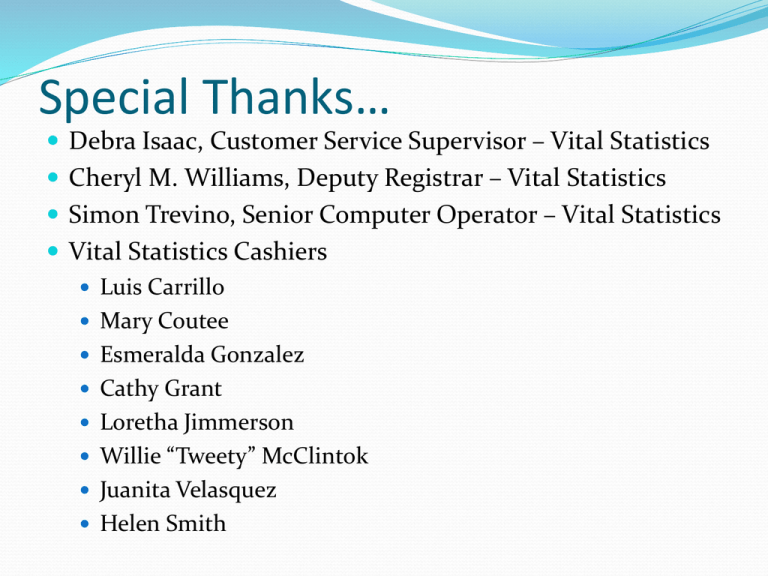
Special Thanks… Debra Isaac, Customer Service Supervisor – Vital Statistics Cheryl M. Williams, Deputy Registrar – Vital Statistics Simon Trevino, Senior Computer Operator – Vital Statistics Vital Statistics Cashiers Luis Carrillo Mary Coutee Esmeralda Gonzalez Cathy Grant Loretha Jimmerson Willie “Tweety” McClintok Juanita Velasquez Helen Smith Larissa Estes Julia Gee Naomi Macias Celina Garza Ridge Varsha Vakil Public Health Department Accreditation Measurement of performance against nationally recognized, evidence- based standards Improve and protect the health of the public by advancing the quality and performance of public health departments Benefits Systematic approach to public health Ensures quality services are provided to residents Enhances visibility and validates commitment to residents Means to obtain additional funding Provides an opportunity to identify areas of performance improvement Why Quality Improvement? Foundation of public health accreditation Accountability Results of investment in public health Declining – do more with less Future funding requirement Getting better all the time Improving performance Improving health outcomes Improving customer satisfaction Definition of Quality Improvement In Public Health “Quality improvement in public health is the use of a deliberate and defined improvement process, such as PlanDo-Check-Act, which is focused on activities that are responsive to community needs and improving population health. It refers to a continuous and ongoing effort to achieve measurable improvements in the efficiency, effectiveness, performance, accountability, outcomes, and other indicators of quality in services or processes which achieve equity and improve the health of the community.” Defining Quality Improvement in Public Health; Journal of Public Health Management & Practice: January/February 2010 - Volume 16 - Issue 1 - p 5–7, Riley, William J. PhD; Moran, John W. PhD, MBA, CQIA, CQM, CMC; Corso, Liza C. MPA; Beitsch, Leslie M. MD, JD; Bialek, Ronald MPP; Cofsky, Abbey - Continuous Improvement Act Plan Check/ Study Do The continuous improvement phase of a process is how you make a change in direction. The change usually is because the process output is deteriorating or customer needs have changed What Is Quality? Today the most progressive view of quality is that it is defined entirely by the customer or end user and is based upon that person's evaluation of his or her entire customer experience. The customer experience is the aggregate of all the Touch Points that customers have with the organization’s product and services, and is by definition a combination of these. (RFT) “Quality is not an act. It is a habit” Aristotle 384BC-322BC, Greek philosopher and scientist, student of Plato and teacher of Alexander the Great Vital Statistics Lobby AIM Statement An opportunity exists to improve the Vital Statistics Customer Flow beginning with customer receipt of ticket number from information window and ending with being called by a cashier to complete financial transaction. This effort should reduce wait time by 15 minutes for the customer. AIM Statement This process is important to work on now because wait times are experienced between the info desk and cashier and to provide good, efficient customer service The baseline measurement is defined as the following metric: Average wait time per cashier window of 28 minutes by cashier by day Methodology Observed the customer waiting area Multiple one-on-one discussions with supervisor and deputy registrar Observed cashiers during several time points during the work week Summary analysis of operational reports Customer Wait Time Transaction Time Print Time Cashier Survey SIPOC+CM Begins with: Customer receiving ticket # from info desk Constraints: •Language •Signage •Volume •Incomplete documentation •Printer •Database, Network •Problematic application searches Measures: Average Customer wait time Cashier feedback Customer feedback Ends with: Customer call to cashier window Process/Activities: • Customer waiting for cashier call (in lobby) •Cashier call Inputs: • # of Customers • # of Cashiers •Supervisor triggers/alerts • Previously completed application (at home, office etc) •Availability of all needed documents Suppliers: • Texas State database • Network Outputs: • Check documents • Begin database search • Send to Print •Complete transaction Customers: •General public (Residents of Texas state) Customer enters Vital Statistics Lobby Flow Chart Is a correct application section complete and required documentation available? Info Desk N Y Call # Assigned Cashier Call Is application information correct? Customer Wait Time: Unknown Y N Complete correct section Customer Wait Time Avg.: 28 min Obtain Correct Information Complete Search Financial Transaction Sent to Printer Print Window Call Pick up Certificate at window #10 Customer Wait Time, includes SOD certificates Avg.: 7 min Leave if cannot complete form or missing docs Fishbone – Cause and Effect •Training, skill set •Communication Wo-Man Power •Database •Equipment •Network, server •Software Mechanical Staffing level •Staffing level Triggers Supervisor calling for back up Wait time of 28 minutes for vital statistic customers Staffing adjustments PROCESS •“problem” certificates •Printing process •Signage/layout Dist of tasks, responsibilities •Staffing Adjustments # of windows open Supervisor moderates flow •Distribution of tasks, responsibilities ↓ customer flow – additional tasks ↑customer flow - ↑# of windows open Pilot Test Idea – transfer 1 person from correspondence to window #6; add lunch coverage 4 windows open at all times Results – June 4th – 8th Plan 1. Identify / Prioritize Opportunities: Customer average wait time more than 28 minutes 2. AIM: Reduce customer wait time to 15 minutes 3. Current Process: Limited number of cashiers to process transactions 4. Collect Data On: Number of cashiers and the wait time per customer 5. Identify Possible Causes: No. of cashier windows open, Printer/network issues, Incomplete documentation etc. 6. Identify Potential Improvements: Increase the number of cashier windows open(especially at rush hour) Vital Statistics 7. Develop Improvement Theory: Create trigger system for supervisor to improve customer flow. Maintain wait time to 15mins. 8. Develop Action Plan: Pilot Program – One additional cashier added from Correspondence and additional cashier/s when wait time exceeds 15 minutes Do Check/ Study 1. Reflect on the Analysis: Data obtained for wait time - 1 Week pilot program. Cashier Survey data 2. Document Problems: Unavailability of Staff and Communication issues. Observation: Smooth running of pilot Lessons learned: Customer Wait time directly proportional to # of cashier window open 1. Implement the Improvement: Implementation of Pilot Program for a week 2. Collect and Document the data: Wait time reduced by 50% 3. Problems, Observations, Lessons Learned Pilot Program Implementation Day 1: Ran a snag – 4 staff out Day 2: Successfully implemented Pilot Program (5 cashier windows open) Day 2-5: Pilot Successfully implemented Act: Adopt Adapt Abandon Standardize Do Plan Houston Department of Health and Human Services (HDDHS) aims to reduce Vital Statistics customer wait time. Situation HDHHS Vital Statistics currently experiencing average customer wait time of 28minutes. Among the reasons for these difficulties is few cashier windows open to serve customers. Inputs Staff: HDHHS QI STAR Trak Team Vital Statistics Priorities: Enhance the ability to serve customers in timely fashion and reduce long wait times Goal: Build avenues to instruct supervisor/s on available resources that can be implemented to reduce customer wait time and assist them to adopt multiple trigger modules to use the available resources. Avenues created are flexible to accommodate all barriers. Materials: Office supplies Cash boxes (Vital Statistics) Equipment: Printers Xerox machines Computers Outputs Activities Outcomes- Impact Participation Short term Medium Term Long Term Develop: Avenues and trigger modules for Vital Statistics Supervisor/s to access other resources/manpower Develop: MOU’s, SOP’s Demonstrate: Develop: Measurable Agreements improvement Execute: between in HDHHS Project Participants: HDHHS Vital Statistics implemented Supervisor/s, Vital Statistics customer after studying the Cashiers, for implementation wait time. Prepare: pros and cons of and Staff of of pilot program Pilot program and fine-tuning the HDHHS Overcome: program , maintain Vital Statistics Prepare: Language barriers Instruct: any progress. Roadmap to and geographical Supervisor/s, implement pilot (satellite location) Cashiers Feedback: Agencies: program barriers. Cashier feedback Satellite location and overcome Identify: (Pilot project) partners and other any foreseen Encourage: Supervisor, Cashier Customer Survey Affiliated partners barriers Staff and staff roles and partners / responsibilities Incentive: Document: to maintain Satisfied customers Pros and Cons usage of available Implement: Pilot reflect job well of Pilot program resources / program for 1 week done by HDHHS manpower. Vital Statistics. Evaluate: Data Assumptions External factors Vital Statistics will work collaboratively to implement the project Staff feels alienated, incentives not good enough to motivate and organizational bureaucracies. Evaluation Demonstrate measureable improvement in Vital Statistics customer wait time. Customer Feedback Survey And Cashier Feedback. Increase in customer satisfaction to access HDHHS Vital Statistics resources. RESULTS Cashier Survey Bureau of Vital Statistics - Cashier Feedback STAR Trak (Blue Team) Pilot program initiative (To be completed by Cashier) Cashier Initials (optional): _________________________________________________ Cashier Work Days and Hours: _____________________________________________ Did you like the STAR Pilot Program Initiative? Yes/No: _______________ Why? (please provide details): ___________________________________ ____________________________________________________________ ____________________________________________________________ ____________________________________________________________ Please provide any suggestion/comments to improve the program: ____________________________________________________________ ____________________________________________________________ Thank you for your participation! Customers waiting in lobby with 4 Cashier Windows Open Pilot program - Friday 06/08/12 at 2 pm Cashier Feedback (N = 6) Q. Did you like the Star TRaK Pilot Program? A. Yes = 5 No = 0 Cashier Comments: “Were able to assist customers faster, continue with more windows open.” “Compliments from customers really made me feel good.” “One [extra] window does make a difference.” “Need to keep more windows open.” “Enjoyed all windows being open, made everything flow smoothly and faster.” “Need more bilingual staff.” Update on improvement efforts Update Cashier Standard Operating Procedures (SOP) Brought on board temporary staff for Vital Statistics Streamlining tasks Workload analysis, results Performance expectations – improved Bureau & staff functionality New vacation/ sick time policy Staffing levels to improve efficiency & effectiveness Next Steps Employee Survey Continue to monitor & Plan Do Check Act Customer Survey Lessons Learned Black box / Ripple effect ??? Cashiers Great customer service skills Efficient and FAST Excellent troubleshooting Control what you can control… Customer Cashier Lessons learned from Vital Open to change, constructive criticism Goal improved customer services Listen to others Suggestions are a way to improve Improvements even better ≠ failure it is an opportunity to make it Questions…
